 |
|
Anthropoid Coffin and Shrine Shaped Box This anthropoid coffin and an accompanying shrine - belonging to a man named Padebhuaset - make a highly unusual pair. |
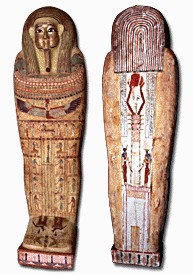 |
The anthropoid coffin itself is typical of the burial practices of the time. The coffin echoes the shape of the mummified body. It is decorated with an idealized representation of the owner's face and with images of gods, goddesses, animals and objects, as well as hieroglyphic writings, that would identify him and help him attain a successful afterlife. |
 |
| More curious, however, is the accompanying shrine-shaped box. The relative size of the two objects make it clear that the anthropoid coffin was not intended to fit inside the box. So it is unlikely that the box is an outer coffin. Perhaps the two objects were meant to play complimentary roles. The images on the anthropoid coffin focus on rebirth and protection of the traditional funerary gods and goddesses. |
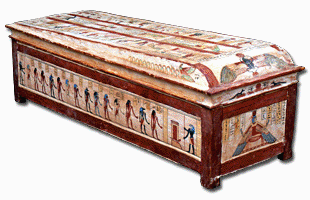 |
The images on the box show beings better known from "magical" literature and books of protection. Specifically, they illustrate scenes from Chapter 182 of the Book of the Dead. |
| The owner's name, Padebhuaset, is rare and means "The one who is the request of Isis." The name was inserted in places left purposely blank by the artists who created the coffin and shrine. In fact, Coffins of varying quality were available "ready-made," mass-produced to meet great demand. Several artists and craftsmen probably worked on a single coffin. Names were added later, much like we personalize objects today by adding monograms or engraving initials. |
| The group of gods, brandishing knives and holding lizards and snakes, are guardians dangerous to anyone who approaches the body of Osiris or the deceased. This scene is described in Chapter182 of the Book of the Dead. |
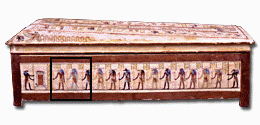 |
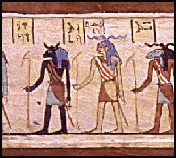 |
| The long lines of walking gods protect the awakening Osiris. This is another scene from Chapter 182 of the Book of the Dead |
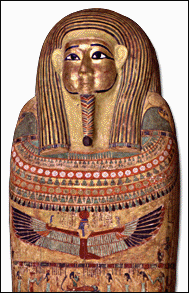 |
The disproportionately large head, sunken into the shoulders,
is a clue to the date of the coffin. Other clues that date this coffin
from the 30th Dynasty to the Ptolemaic Period (between 380-30 BC) include:
the broad collar begins below the bottom of the wig; the collar terminates
in two large falcon heads; the overall large size of the coffin; and the
high footcase. The sky goddess Nut, her head topped by a sun-disk, spreads her wings across the mummy's chest in a gesture of protection. The columns of text around her assure the deceased of protection against all evil. |
|
The jackal-headed god Anubis, god of embalming, attends to the mummy
of the deceased. The mummy rests on a lion-headed couch.
|
 |
 |
|
30th Dyansty - Late Ptolemaic period "Anthropoid Coffin and Shrine Box of a Man Named
Padebhuaset" |
 |
 |
 |
 |
 |
 |
© Michael C. Carlos Museum of Emory University,
Memorial Art Gallery of the University of Rochester and Dallas Museum of Art
For more information please contact odyssey@emory.edu.
Last Update: